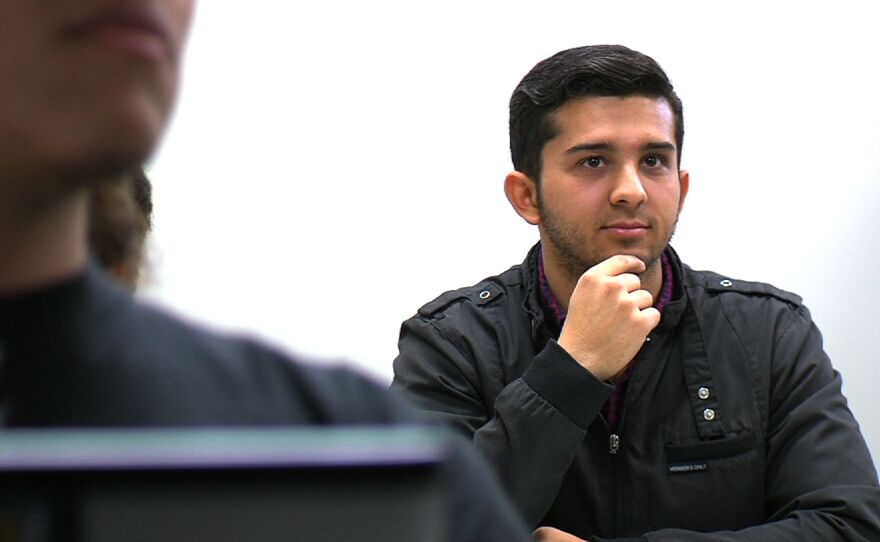Finishing a bachelor's degree at one of California’s public universities in four years is increasingly difficult. Competition for seats in the state’s overenrolled classes has students looking across the border.
In fact, anyone who has tried to complete a transfer degree at a local community college can probably relate to the frustration Alfredo Brambila felt while he was a student at Mesa College.
”If you wanted to get a class, you had to crash (to get places that open up when registered students don't show) and there wasn't enough space," he said. "It's just not easy. It's not easy to just go through the process of college."
During the recession, San Diego Community College District campuses lost about 2,600 class sections to state funding cuts. Brambila went to high school in San Diego and always planned to get an American college degree. But that goal was still a long way off after two and a half years at Mesa.
“One day I went to talk to a counselor and I told him, just point blank: 'how much time is it going to take me to transfer and graduate?'" Brambila said, "and he told me about four to five years.”
Instead of taking on at least seven years of college, he considered going to Centro de Enseñanza Técnica y Superior, a private university in Tijuana commonly called CETYS.
“I could study the same career and, if I apply myself, I could graduate in three years and a half,” he said.
Now Brambila’s in his second year at the school’s sleek campus on a hill overlooking eastern Tijuana.
Eduardo Diaz heads the international business program at CETYS. His educational background follows a familiar storyline. He was born in the U.S., but raised mainly in Tijuana. He moved back for high school and to get a bachelor’s degree at San Diego State. But, he said, students like Brambila started trickling onto the CETYS campuses in Tijuana and Mexicali when the recession slashed California’s budget.
“When students started having trouble getting into local colleges because of budget cuts, some of the high school counselors in Southern California started looking for options because they wanted to help their students,” Diaz said.
And now that trickle is a steady stream. This year about 300 graduates from Southern California high schools are enrolled in CETYS undergraduate programs — up from about 50 in 2010.
Diaz said attracting students who are intent on finishing their degrees on time helps the university achieve one of its primary goals.
“Our goal is to be an institution of quality that sets a very clear timetable for students," he said. "We work so that they can graduate, because nobody’s productive unless they’re working, that’s one of the things that we believe. So we want our graduates to be productive.”
An improving financial picture for California's public universities is unlikely to stop the flow. The university expects another 75 to 100 California high school grads to enroll next fall, according to Fernando León García, the school's president. León García is also working toward a guaranteed transfer agreement with Imperial Valley College.
Alfredo Brambila said he’s happier at the Mexican school. Like many of the other students coming from the U.S., he has family in Tijuana. He also liked being in classes in his major — electrical engineering — right away instead of going through California’s general education requirements first.
“If you are studying med school, engineering, law school anything — you get to do special classes since first or second semester, third semester, fourth semester," he said. "And that’s the time when you say, this is really for me.”
According to a brochure on the school's website, tuition is about 50,000 pesos per semester, which comes to about $3,700, depending on the current conversion rate. In-state tuition at San Diego State this year is just a little less, about $3,400 per semester. Last year at San Diego State, about 30 percent of full-time students managed to graduated in just four years.
Brambila, like more than half of CETYS students, gets financial aid. He said he pays about half of the normal tuition.
U.S. federal aid can even follow students across the border to CETYS, since the university was accredited by the Western Association of Schools and Colleges in 2012. It's one of four Mexican universities with a U.S. accreditation. That accreditation means graduates’ degrees will also mean more to U.S. employers, which Diaz said is important for the school’s future.
“A lot of these students are U.S. citizens, once they finish at CETYS, they’re going back to the United States and that’s where they’re going to develop their professional careers," he said. "Actually, it’s too early to tell, but we want these young professionals to succeed and they are the ones who are going to raise our profile in the United States in practice.”
CETYS President León García said the school could build on that reputation with satellite programs in the U.S. in the future.






